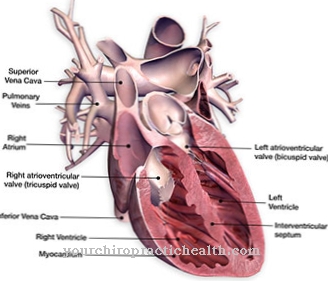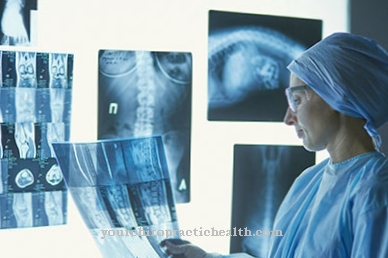Breast cancer, Breast cancer or. Breast cancer is a malignant cancer of the mammary glands. This tumor is most common in women. There are almost 60,000 people with burst cancer in Germany each year. Typical signs of breast cancer are lumps and nodules in the breast area. Since there are hardly any other symptoms, an annual examination for early detection is useful.
What is breast cancer?

Breast cancer or breast cancer is a malignant disease of the lobules of the mammary glands (lobular carcinoma) or, more often, of the duct epithelium (ductal carcinoma). In Germany it is the most common cancer in women, around every eighth to tenth woman will develop the disease in the course of her life.
The incidence is still increasing, but good screening programs (especially mammography from the age of 50) can often detect breast cancer in its early stages. The therapy options have also continuously improved, so that a significant reduction in mortality has been achieved. In Germany, up to 70% of breast cancer diseases can be cured or at least brought to a standstill.
causes
A single direct cause of breast cancer is rarely identified. Exceptions are e.g. the genetically caused breast cancer diseases, which only make up around five percent (mutations in the genes BRCA-1 and BRCA-2).
Otherwise, the individual risk can be estimated using risk factors. In addition to familial accumulation, long exposure to hormones also plays a decisive role. Accordingly, early menarche, late menopause and no or late pregnancies are risk factors. Breastfeeding and many pregnancies have a protective (protective and preventive) effect. The hormone dependence is also often reflected in the tumor itself.
Some forms are able to develop estrogen and progesterone receptors. This fact is also used therapeutically. General factors such as obesity, smoking, a history of other cancer, and exposure to ionizing radiation also increase the risk of developing breast cancer.
Symptoms, ailments & signs

Breast cancer symptoms may include lumps, retraction of the mammary gland, and watery or bloody discharge from the mammary gland. At the beginning, breast cancer does not cause any discomfort or pain. Only as the disease progresses can hardening or lumps appear in the breast, which can usually be felt from the outside.
As the disease progresses, swelling may appear in the armpit area, often below the collarbone or next to the breastbone. Occasionally there is also swelling in the area of the abdomen and back, depending on the severity of the disease, a possible metastasis. Some women notice an enlargement of one or both breasts.
As the disease progresses, the nipples can change and become inflamed. Dents, dimples or enlarged pores in the breast area also indicate a disease that needs to be examined by a doctor. With the progression of the disease and metastasis of the tumors, unspecific complaints increasingly arise.
Depending on the location of the metastases, pain in the bones or in the abdomen occurs, for example. You may also experience shortness of breath, nausea and vomiting, exhaustion and a persistent feeling of illness.
Complications
Breast cancer complications are particularly associated with surgical treatment of the disease. The wound cavity can become infected and scarring. Infection and severe scarring are factors that are particularly common in smokers and diabetics.
Since the patients do not move during the operation and hardly move afterwards, the risk of thrombosis and embolism increases considerably. In addition, the blood vessels can subsequently open and the resulting bleeding may result. Usually this problem can be solved with a pressure bandage.
However, a small percentage of patients will require further surgery. As part of this so-called revision operation, drains must then be placed. These are plastic tubes that transport blood, wound secretions and other accumulations of fluid to the outside.
In addition, complications in the treatment of breast cancer often occur as side effects of the chosen therapy. The cells in the gastrointestinal tract and in the hair divide as often as cancer cells. Therefore, they often suffer very badly from chemotherapy. Nausea, vomiting and gastrointestinal bleeding occur. The hair falls out and does not renew itself while chemotherapy continues.
When should you go to the doctor?
If you feel your chest yourself regularly, you can detect any changes faster and more easily. It could be anything. Skin changes on the nipple, a retraction of the nipple, or fluid leakage from the nipple should be examined by the gynecologist as soon as possible and without long waiting. Skin changes on the breast that resemble orange peel are also among the warning signs.
A sudden change in the size of one of the breasts or changes in the mobility of the breast can also be signs that you have breast cancer. Pain rarely occurs with breast cancer, but if there is burning pain in the chest, a visit to the gynecologist is strongly recommended.
If swelling of the lymph nodes under the arm is found when palpating the chest, this should also be monitored. Lymph node swellings can of course also have harmless reasons. A quick clarification with the gynecologist is necessary here. Only there can further examinations such as mammography and ultrasound clarify what these changes are. Very often there is a harmless explanation, but a timely visit to the doctor can also be life-saving.
Doctors & therapists in your area
Treatment & Therapy

Surgical therapy comes first in breast cancer. If possible, surgery is performed to conserve the breast. Accordingly, only the tumor is removed with a sufficient safety margin. However, if the tumor is localized in several places (multicentric), if it is very large in relation to the remaining breast or if it is already caked with skin or pectoralis muscle, the entire breast must be removed (ablation).
In the case of invasive breast cancer, the sentinel lymph node is also removed intraoperatively. Only if this is histologically affected, level II and III of the axillary (armpit) lymph nodes are also resected. If surgery was performed to conserve the breast, irradiation of the remaining breast is mandatory. After an ablatio mammae, a decision is made based on the risk factors, tumor stage and the patient's wishes. In addition, chemotherapy can be carried out. If the tumor is very large or if there is inflammatory breast cancer, a so-called neoadjuvant therapy can also be carried out before the operation to reduce the tumor mass.
Postoperative chemotherapy is carried out depending on the risk constellation, tumor stage and metastasis. If breast cancer develops hormone receptors, hormone therapy (depending on the menopausal status) should be used adjuvantly. This therapy is used as a direct measure, but also to prevent recurrences. Tumor-specific antibodies (Herceptin) are a very recent form of therapy. This antibody against the Her-2 / neu receptor is mainly used in metastatic breast cancer.
Outlook & forecast
The prognosis for breast cancer has improved considerably in recent years. With early diagnosis and prompt treatment, the chance of a cure for breast cancer is extremely good. Measured from the time the disease was diagnosed after 5 years, almost 90% of 100 patients are still alive. If no further complications occur, most patients can be discharged as cured after surgery and subsequent cancer therapy.
In many cases, new tumors or secondary tumors form at the tumor site as the disease progresses. It is important to monitor this and treat it in good time so that a new cancer outbreak is avoided. Patients under the age of 35 are more likely to suffer a relapse of the disease and thus a recurrence of breast cancer. If the breast tissue is completely removed, the risk of a new outbreak is significantly reduced.
The prognosis for breast cancer changes with the size of the tumor discovered. The larger this is, the higher the probability that the lymphatic system will also be infected by cancer cells in addition to the breast. The chances of a cure also diminish once metastases have formed on the body. The chances of recovery also depend on the type of breast cancer. In direct comparison with inflammatory breast cancer, tubular breast carcinoma has a more favorable prognosis.
Aftercare
When it comes to breast cancer, freedom from symptoms does not mean that everything is okay. Follow-up care is very important for cancer. As far as we know today, breast cancer is considered a chronic cancer. The possibility of sequelae and recurrence is high.
Many sufferers suffer from exhaustion for years after chemotherapy, radiation and surgery. Serious side effects can occur during treatment. The psychological stress should not be underestimated either. Follow-up care is also important because many breast cancer patients have been given anti-hormonal preparations for years. Adjuvant therapies must be monitored.
As long as the breast cancer has not spread, follow-up care begins immediately after primary care. Clinical check-ups are necessary at regular intervals in order to detect recurrences at an early stage. Therapeutic sequelae usually have to be treated over a long period of time. Rehabilitation measures and psychotherapeutic offers are also part of the aftercare.
In most cases, gynecologists or general practitioners are the contact persons for follow-up care after the rehabilitation phase. Regular palpation examinations and detailed surveys provide information about possible treatment options. If necessary, advice centers or self-help groups can provide some of the mental support. The aftercare measures should follow a specific schedule. The German Cancer Society has drawn up guidelines for this.
The frequency of follow-up visits changes over time. How often aftercare measures are necessary, however, also depends on individual circumstances, family history, and the severity and type of breast cancer.
You can do that yourself
The diagnosis of breast cancer always means a change in lifestyle for those affected. In addition to medical treatment, various accompanying measures are offered today to make it easier for those affected and their relatives to deal with the disease.
By talking to other breast cancer patients, but also to friends and family members, you can share your own experiences in dealing with the disease on a daily basis. This and measures such as sport, a change in diet and finding new hobbies can improve the quality of life. Expert support can also be obtained from psychological cancer counseling centers. In the longer term, those affected can turn to a psychotherapist or go to self-help groups.
Counseling is also advisable because of the social risks of cancer, for example when returning to work is at risk or caring for the family is no longer possible. In these cases, experts trained in social law can help to regulate personal matters. Finally, those affected can also resort to alternative healing methods. The effectiveness of these methods has not necessarily been proven with the means of scientific-clinical testing. However, additional steps can give hope and make everyday life with the disease easier.

.jpg)
.jpg)
























